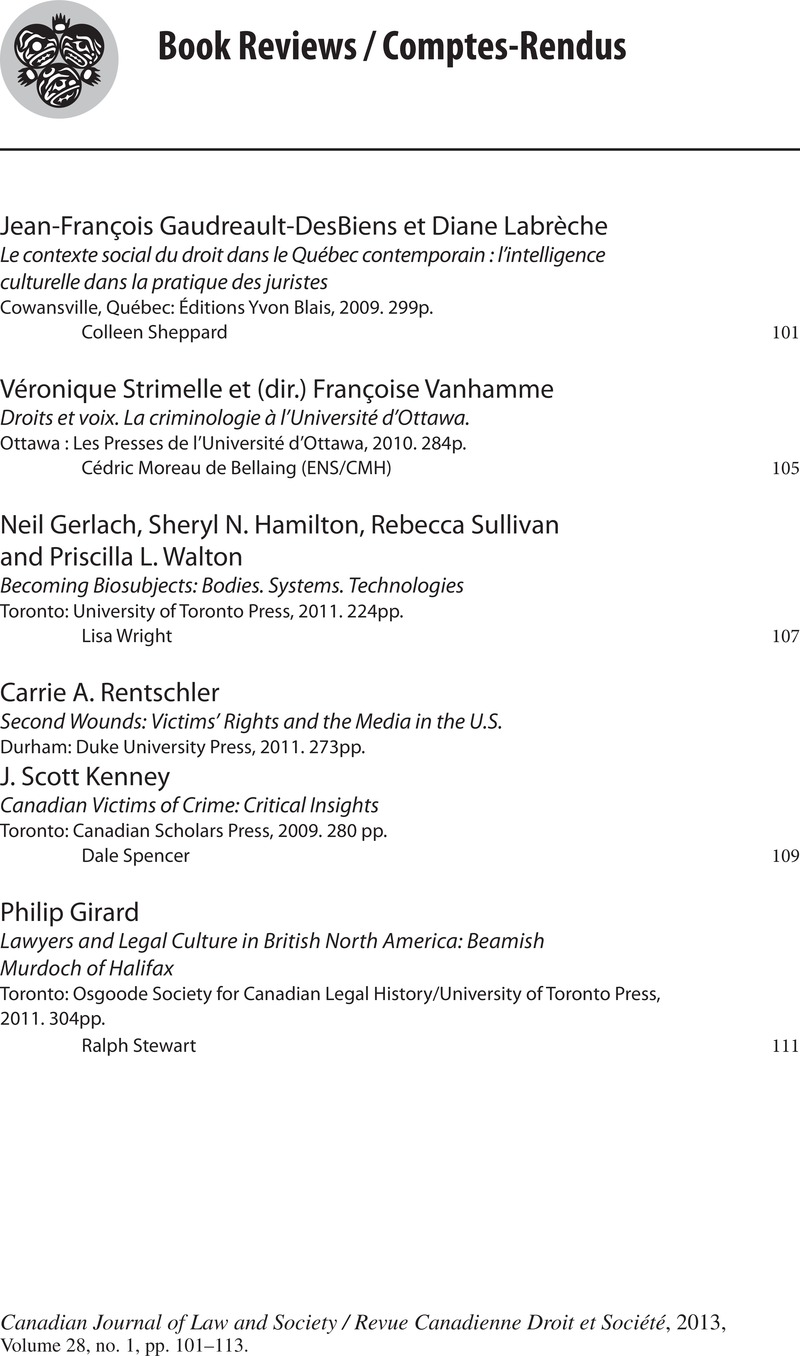No CrossRef data available.
Published online by Cambridge University Press: 15 May 2013

1 Gaudreault-DesBiens and Labrèche, Le contexte social du droit dans le Québec contemporain, 11–13.
2 To ensure a wider readership, given the continuing limits of bilingualism in Canada, it is good news that an English translation is being published.
3 Ibid., x.
4 Ibid., 9–10. By “extra-legal” the authors are referring to legal regimes and norms (such as canon law) that are not a part of the formal state-based legal system, but understood as law by scholars of legal pluralism. In this regard, they cite Guy Rocher, “Pour une sociologie des ordres juridiques” 29 C. de D. 91 (1988); Jean-Guy Belley, “L’État et la régulation juridique des sociétés globales. Pour une problématique du pluralisme juridique,” Sociologie et sociétés 18, no. 1 (1986) : 11; and Emmanuel Melissaris, “The More the Merrier? A New Take on Legal Pluralism,” Social & Legal Studies 13 (2004): 57.
5 Gaudreault-DesBiens and Labrèche, ibid., 33, citing David C. Thomas and Kerr Inkson, Cultural Intelligence, People Skills for Global Business (San Francisco: Berrett-Koehler Publishers, 2004), 14–15.
6 Seven key competencies for the development of cultural intelligence are identified in the book, including: adaptability, curiosity, observation, creativity, emotional intelligence, knowledge of one’s own culture, and a decentering of one’s own culture (44). Two key obstacles to the development of cultural intelligence in the Quebec legal profession are highlighted in the book. One obstacle is the lack of diversity within the profession itself: “. . . Un jurist œuvrant dans un milieu homogène a inévitablement moins de possibilités qu’un autre qui évolue dans un environnement plus hétérogène de développer, par le truchement d’expériences vécues au quotidien, des mécanismes d’adaptation à la diversité” (29–30) The second obstacle is linked to the failure of legal education to confront issues of social diversity, exclusion, and inequality. The authors suggest that legal education in Quebec has historically been overwhelmingly focused on positive law, and as a result, its “contextes d’élaboration, d’interprétation et de mise en application étaient plus ou moins occultés” (31).
7 Ibid., 33–34.
8 Ibid., 10. For a similar articulation of the limits on contextualism, see Martha Minow & Elizabeth V. Spelman, “In Context,” Southern California Law Review 63 (1990): 1597 at 1605; Colleen Sheppard, Inclusive Equality–The Relational Dimensions of Systemic Discrimination in Canada (Montreal: McGill-Queen’s University Press, 2010), chapter 3.
9 Gaudreault-DesBiens and Labrèche, ibid., 25. For example, consideration of economic marginalization, addiction, single-parent status need not be linked to specific grounds of discrimination. Furthermore, the doctrinal tests developed to ascertain violations of s 15 of the Canadian Charter of Rights and Freedoms need not be applied. The equality principles that govern a contextual approach provide a normative framework for legal advocacy, adjudication, and interpretation.
10 Gaudreault-DesBiens and Labrèche, ibid., 107
11 Ibid., 115.
12 Gaudreault-DesBiens and Labrèche, ibid., 130.
13 Two cases discussed in the book that left me questioning whether the authors had gone too far in insisting on individualized proof include: R. v Hamilton, (2004) 72 OR (3d) 1 (Ont CA), where the authors endorse the Ontario Court of Appeal decision, and Van de Perre v Edwards, [2001] 2 SCR 1014, where they agree with the Supreme Court of Canada’s approach in that case to the race issue. For a critique of the Hamilton decision, see Richard Devlin and Matthew Sherrard, “The big chill? Contextual judgment after R. v. Hamilton and Mason,” Dalhousie Law Journal 28 (2005): 409. For a critique of the failure of the Supreme Court of Canada to examine more fully the issues of race and racism in the Van de Perre case, see Lawrence Hill, Black Berry Sweet Juice–On Being Black and White in Canada (Toronto: HarperCollins, 2001), 150–72.
14 Gaudreault-DesBiens and Labrèche, ibid., 174–80.